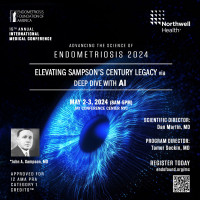
Endometriosis, a disease that is said to affect one in ten women in the United States, and is often characterized as a disease of inflammation. In reaction to the presence of out of place endometrial tissue (endometriosis), the body is said to develop inflammation. In addition, the estrogen proliferation that these ectopic lesions are noted to cause can further promote inflammation. This serves as a connection as to why so many physicians have sought to use hormone therapy as a way of managing endometriosis pain and symptoms. However, even when on estrogen suppression, endometriosis patients will still have increased levels of inflammation and can still experience symptoms. Thus, new methods for both treating and diagnosing endometriosis are currently being investigated, and the role that inflammation plays in the aggravation of the disease is central to the development of such innovations.

In a study conducted at the Southern Illinois University School of Medicine, it is hypothesized that the high inflammatory response noted in endometriosis patients can be connected to unique changes in the body’s microbiome. The body is highly well tuned to maintain homeostasis or balance. Part of this job includes having a highly effective immune system that is capable of “fighting off” unwanted pathogens and diseases when they are detected within the body. Our immune cells thus highly influence the microbial environments within our body, and inflammation is one example of such. “We believe that endometriosis may have a unique microbial profile due to the fact that endometriosis is associated with inflammation and the influence immune cells can have within our own microbial environment,” states Dr. Andrea Braundmeier-Fleming, a co-author of the study and an assistant professor in the department of medical microbiology, immunology, and cell biology. “Therefore, identifying specific characteristic changes in a person’s microbial environments could depict immune shifts and signal that a person is in an ‘inflamed’ state.”
In the pilot study published in Reproductive Immunology in September, Dr. Braundmeier-Fleming and her colleagues collected urogenital swabs and uterine washes from 19 women undergoing laparoscopic surgery for pelvic pain. Of these 19 women, nine served as the control group as they were undergoing laparoscopic surgery for benign ovarian/uterine conditions, while the other ten women were suspected of having endometriosis. Following a year, patients had a repeated cervical swab and bacterial community composition was assessed. The results showed significant differences in bacterial communities between sample sites, as endometriosis stage III patients showed both an increase in bacterial richness and phylogenetic diversity. But this raises the question, how can this supposedly unique endometriosis microbial profile better enhance further treatment and diagnosis of the disease itself?
Dr. Andrea Braundmeier-Fleming is the senior author of the study published in Reproductive Immunology and is an assistant professor in the department of medical microbiology, immunology, and cell biology at Southern Illinois University School of Medicine in Springfield.

Surgeons and endometriosis specialists alike believe the only way to definitively diagnose endometriosis is through excision surgery with an accompanying pathology report. Thus, a significant factor contributing to the difficulty of relieving patients of their chronic pain and infertility associated with endometriosis is that there is no biomarker, routine blood test, genetic test or imaging technology that can diagnose endometriosis as accurately as laparoscopic surgery. However, these study results propose bacterial community profiling, through minimally invasive samples such as vaginal swabs or urine samples, may provide a useful diagnostic tool for identifying endometriosis in asymptomatic, infertile women. This can be done during routine office visits similar to screening for cervical cancer with Pap smears. “We just need to determine the microbial profile specific to different inflammatory conditions such as endometriosis,” says Dr. Braundmeier-Fleming. Success in this research area would then reduce or potentially eliminate the need for laparoscopic surgical intervention for the purpose of diagnosis. It would also provide a clinician with more information, allowing for more personalized treatment options at a much earlier stage
The Endometriosis Foundation of America looks to promote research opportunities aimed at further improving early detection and treatment of endometriosis. As such, the foundation honored Dr. Braundmeier-Fleming and her investigators with research funding to continue their work. Today, Dr. Braundmeier-Fleming reports, “the next steps of the study are to do our own microbiome screening with more patients and try to determine if we can identify a profile for each stage of the disease. This way clinicians would not only be able to tell a patient that they have endometriosis but also tell patients the severity of the disease.” With a larger longitudinal study and further clinical data, Dr. Braundmeier-Fleming is hoping to identify a microbial signature unique to endometriosis, allowing for future development of an actual diagnostic tool that will enable early, non-surgical detection of endometriosis.









